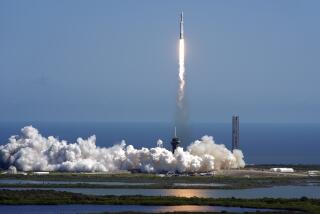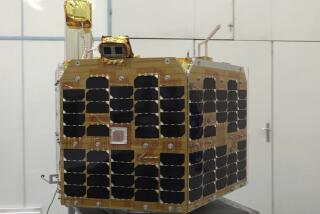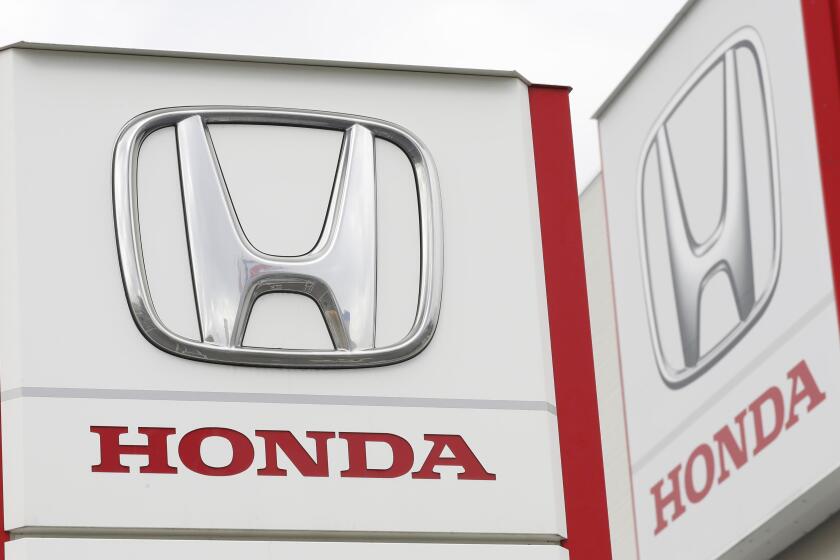SpaceX, in another advance, launches supplies to space station in a reused capsule
SpaceX launched supplies to the International Space Station in a previously used spacecraft Saturday and then landed the rocket’s first-stage booster back on Earth.
With the launch, SpaceX’s Dragon capsule joins a small number of spacecraft, most notably NASA’s space shuttles, to reenter space — a first for the Hawthorne space company.
The Falcon 9 rocket lifted off a little after 2 p.m. Pacific time from Launch Complex 39A at the Kennedy Space Center in Florida. The launch had originally been set for Thursday afternoon but was scrubbed because of weather conditions.
The Dragon capsule for this mission was used in 2014 to carry supplies to the space station. For this launch, it was filled with almost 6,000 pounds of crew supplies, hardware and science research, including equipment to study neutron stars.
In preparation for the flight, SpaceX replaced some parts on the Dragon, such as the heat shield. But most of the components, including the hull and thrusters, were reused, said Hans Koenigsmann, vice president of mission assurance at SpaceX.
“The majority of this Dragon has been in space before,” he said during a prelaunch news conference earlier this week.
About seven minutes after launch, the Falcon 9’s first-stage booster landed upright at nearby Cape Canaveral Air Force Station.
Successful landings for the first-stage booster have become so reliable that inspection processes for the booster will be streamlined from now on, Koenigsmann said at a post-launch news conference Saturday.
The Dragon spacecraft deployed about 10 minutes after launch and should arrive at the space station around 7 a.m. Pacific time Monday. The spacecraft is expected to return to Earth in July, splashing down in the Pacific Ocean.
SpaceX will then evaluate the Dragon, and if all goes well, the capsule could then be reused “a couple” more times, Koenigsmann said.
Reusing a Dragon capsule is “one more piece of the puzzle” in creating a fully reusable launch system, said Marco Caceres, senior space analyst at the Teal Group.
In March, SpaceX achieved one of its longtime goals by using a previously flown first-stage booster to launch a commercial communications satellite and then landing that booster on a floating platform at sea.
During that same mission, the company successfully recovered the rocket’s fairing, a clamshell-like covering that protects satellites and other payloads.
Successful reuse of the Dragon capsule is significant for SpaceX’s materials technology, but in general, the spacecraft reuse is less significant than that of the booster, which required “more cutting-edge” technology to be able to land upright, Caceres said.
SpaceX Chief Executive Elon Musk has said the first-stage booster is the most expensive part of the rocket. Company President Gwynne Shotwell has said that launch costs could eventually decrease by 30% by reusing rockets.
Saturday’s launch was SpaceX’s seventh of the year as the company increases its launch cadence. Last year, SpaceX launched eight missions before a launchpad explosion that destroyed a rocket and commercial satellite, grounding the company for several months.
Twitter: @smasunaga
ALSO
Rocket Lab’s Electron rocket reaches space, but not orbit, in first test flight
Uber’s head of aviation talks about its plan for air transport. (Just don’t call it a flying car.)
Air traffic control for drones is coming. Here’s how it could work
UPDATES:
June 3, 5:50 p.m.: This article has been updated for additional details and for clarity.
June 3, 4:30 p.m.: This article was updated to include comments from a post-launch press conference.
June 3, 2:50 p.m.: This article was updated with details about the SpaceX launch.
June 3, 1:50 p.m.: This article was updated to include details about SpaceX’s launch attempt Saturday.
June 1, 3:15 p.m.: This article was updated with SpaceX’s announcement of a launch delay.
June 1, 6:50 a.m.: This article was updated with a clarification about why there will be no fairing recovery.
This article was originally published June 1 at 6 a.m.
More to Read
Inside the business of entertainment
The Wide Shot brings you news, analysis and insights on everything from streaming wars to production — and what it all means for the future.
You may occasionally receive promotional content from the Los Angeles Times.











